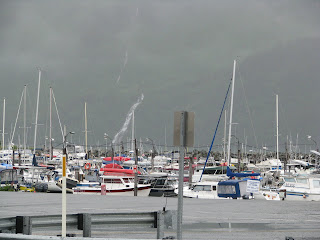
Mini Glacier Icebergs in the water
Notice the blue tint to the super compressed ice. Almost all glacier travelers have stared with awe into the brilliant blue depths of an open crevasse. The bright white snow of the surface is a marked contrast to the deep rich blue inside a glacier. But why is ice blue? Snow is white because full spectrum, or white, light is scattered and reflected at the boundary between ice and air. The white color of bubbles at the top of a dark beer work the same way—small pockets of air reflect and scatter visible light. Ice only appears blue when it is sufficiently consolidated that bubbles do not interfere with the passage of light. Without the scattering effect of air bubbles, light can penetrate ice undisturbed. In ice, the absorption of light at the red end of the spectrum is six times greater than at the blue end. Thus the deeper light energy travels, the more photons from the red end of the spectrum it loses along the way. Two meters into the glacier, most of the reds are dead. A lack of reflected red wavelengths produces the color blue in the human eye. Now you know the rest of the story.
 The Anton Anderson Memorial Tunnel (often referred to simply as the Whittier Tunnel) is a tunnel through Maynard Mountain in the U.S. state of Alaska. It links the Seward Highway south of Anchorage with the relatively isolated community of Whittier. It is part of the Portage Glacier Highway and at 13,300 feet (4,050 m), is the second longest highway tunnel and longest combined rail and highway tunnel in North America. The original tunnel was completed in 1943 and used for railroad traffic. In the mid-1960s, the Alaska Railroad began offering a shuttle service for automobiles, similar to Amtrak's Auto Train, which allowed vehicles to drive on to rail cars to be transported between Whittier and the former town of Portage. As traffic to Whittier increased, the shuttle became insufficient, leading in the 1990s to a project to convert the existing railroad tunnel into a one-lane, combination highway and railroad tunnel. Construction on this project began in September 1998, and the combined tunnel was opened to traffic on June 7, 2000. As eastbound traffic, westbound traffic, and the Alaska Railroad must share the tunnel, there are often waits of 20 minutes or more to enter. As reflected on the Alaska Department of Transportation Tunnel Website, it is now considered "North America's longest railroad-highway tunnel." The tunnel held the title of the longest road tunnel in North America (at nearly 2.5 miles [4 km]) until completion of the 3.5 mile (5.6km) Interstate 93 tunnel as part of the "Big Dig" project in Boston, Massachusetts. It was a 2001 recipient of an Outstanding Civil Engineering Achievement Award from the American Society of Civil Engineers. The tunnel is named after Anton Anderson, an army engineer who in 1941 headed up the construction of the railroad spur from Whittier to Portage
The Anton Anderson Memorial Tunnel (often referred to simply as the Whittier Tunnel) is a tunnel through Maynard Mountain in the U.S. state of Alaska. It links the Seward Highway south of Anchorage with the relatively isolated community of Whittier. It is part of the Portage Glacier Highway and at 13,300 feet (4,050 m), is the second longest highway tunnel and longest combined rail and highway tunnel in North America. The original tunnel was completed in 1943 and used for railroad traffic. In the mid-1960s, the Alaska Railroad began offering a shuttle service for automobiles, similar to Amtrak's Auto Train, which allowed vehicles to drive on to rail cars to be transported between Whittier and the former town of Portage. As traffic to Whittier increased, the shuttle became insufficient, leading in the 1990s to a project to convert the existing railroad tunnel into a one-lane, combination highway and railroad tunnel. Construction on this project began in September 1998, and the combined tunnel was opened to traffic on June 7, 2000. As eastbound traffic, westbound traffic, and the Alaska Railroad must share the tunnel, there are often waits of 20 minutes or more to enter. As reflected on the Alaska Department of Transportation Tunnel Website, it is now considered "North America's longest railroad-highway tunnel." The tunnel held the title of the longest road tunnel in North America (at nearly 2.5 miles [4 km]) until completion of the 3.5 mile (5.6km) Interstate 93 tunnel as part of the "Big Dig" project in Boston, Massachusetts. It was a 2001 recipient of an Outstanding Civil Engineering Achievement Award from the American Society of Civil Engineers. The tunnel is named after Anton Anderson, an army engineer who in 1941 headed up the construction of the railroad spur from Whittier to Portage


There is not much above than just the rock they carved the longest tunnel in North America through.








The building now stands in ruins. Somebody was busy with their sling shot.

The only housing in Whittier - A 15 story housing high rise building.
The Whittier Zoo. One animal - a reindeer.
The halibut I wish I had caught.
A cruise ship loading up with thousands of people.











No comments:
Post a Comment